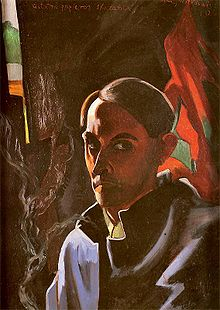Polish Beckett Stanisław Ignacy Witkiewicz

Stanisław Ignacy Witkiewicz 24 February 1885 – 18 September 1939), commonly known as “Witkacy“, was a Polish poet, playwright, novelist, painter, photographer and philosopher.
Stanisław Ignacy Witkiewicz, aka Witkacy, was born on the 24th of February, 1885 in Warsaw and died by committing suicide upon learning of the Red Army’s attack on Poland, on the 18th of September, 1939 in the village of Jeziory, Polesie region (present-day Ukraine).
“He created a theater of the absurd twenty years before Beckett, Ionesco, and Genet. He himself was a living model of the avant-garde, advancing the frontiers of drama, fiction, aesthetics, philosophy and painting” (Daniel Gerould)
The accomplishments of his life’s 54 years could well be distributed among several hard-working biographies. Witkacy has become a classic in front of our eyes, one of the most frequently translated Polish authors, and his texts have been transcribed into more than 30 languages and released in countries across Europe, South America, as well as the United States and Japan. Witkacy is also the most frequently performed Polish playwright of the global theatre scene.
In his 1975 book entitled Witkiewicz, albo Realizm nieoczekiwany (Witkiewicz or Unexpected Realism), Jan Kott wrote
Witkiewicz was a catastrophist, gifted like Orwell – both the Orwell of Animal Farm and the Orwell of 1984 – with stunning clarity and acute vision. He had said that civilizations of the equal, satiated and automatized will be threatened not only by the pressure of ‘annihilators’ from the East, Asia and Africa, but also by the fact that mechanized civilizations are frail and prone to insanity, and helpless in the face of madmen and psychopaths. In a world that has become a global village, madness is contagious and common. In this great village, where everything happens at once, everything has suddenly become possible.
Enigmatic persona….
Janusz Degler chose to entitle the biography of this multitalented creator Witkacego Portret Wielokrotny (Witkacy’s Multiple Portrait), as he also owned a multitude of faces. The self-portraits of Witkiewicz make it very difficult to decide what was his eye colour, for example. Depending on the composition, they were brown, various shades of black and grey, at other times green or purple. One of the actresses remembered him in the following way:
‘’He was beautiful. Tall, well-built, with dark hair and a dark, seemingly brooding face, which got suddenly lit up with very light blue eyes. He had a poignant gaze, a steel one. He came to Łódź, because we were meant to perform his play ‘Persy Zwierżątkowskaja’. It was a pre-premiere, after the Madman and the Nun, and Jan Maciej Karol Wścieklica. And once again, a surprise. Stanisław Ignacy Witkiewicz was incredibly modest. He did not believe in success, nor was he convinced of the exceptional quality of his play. He came to the last rehearsals. I suppose it is needless to add that the play was shocking for us every possible way. The content? Today I don’t attempt to describe it, I simply don’t remember. But I clearly remember the words with which Witkiewicz responded to our pressing questions: ‘There are three basic motors of all human activity: money, women, and power’. Each of the three acts corresponded with one of these affairs. But in the end, it was money that won.’’
His life……
Born in Warsaw, Stanislaw Ignacy Witkiewicz was the son of painter, architect and art critic Stanislaw Witkiewicz. His mother was Maria Pietrzkiewicz Witkiewiczowa. Both of his parents were born in the Samogitian region of Lithuania. His godmother was the internationally famous actress Helena Modrzejewska.
Witkiewicz was reared at the family home in Zakopane. In accordance with his father’s antipathy to the “servitude of the school,” the boy was home-schooled and encouraged to develop his talents across a range of creative fields.
Witkiewicz was close friends with Karol Szymanowski and, from childhood, with Bronislaw Malinowski and Zofia Romer. Following a crisis in Witkiewicz’s personal life due to the suicide of his fiancée Jadwiga Janczewska, he was invited by Malinowski to act as draftsman and photographer on a 1914 expedition to Oceania, a venture that was interrupted by the onset of World War I.
On his return, Witkiewicz, a citizen of the Russian Empire, went to St Petersburg and was commissioned an officer in the Imperial army. His ailing father, a Polish nationalist, was deeply grieved by the youngster’s decision and died in 1915 without seeing his son again.
Witkiewicz lived through the Russian Revolution in St Petersburg. He claimed that he worked out his philosophical principles during an artillery barrage, and that when the Revolution broke out he was elected political commissar of his regiment. His later works would show his fear of social revolution and foreign invasion, often couched in absurdist language.
He had begun to support himself through portrait painting and continued to do so on his return to Zakopane in Poland. He soon entered into a major creative phase, setting out his principles in New Forms in Painting and Introduction to the Theory of Pure Form in the Theatre. He associated with a group of “formist” artists in the early 1920s and wrote most of his plays during this period. Of about forty plays written by Witkiewicz between 1918 and 1925, twenty-one survive, and only Jan Maciej Karol Hellcat met with any public success during the author’s lifetime. The original Polish manuscript of The Crazy Locomotive was also lost; the play, back-translated from two French versions, was not published until 1962.
After 1925, and taking the name ‘Witkacy’, the artist ironically re-branded the paintings which provided his economic sustenance as The S.I. Witkiewicz Portrait Painting Firm, with the motto: “The customer must always be satisfied”. Several grades of portrait were offered, from the merely representational to the more expressionistic and the narcotics assisted. Many of his paintings were annotated with mnemonics listing the drugs taken while painting a particular painting, even if this happened to be only a cup of coffee. He also varied the spelling of his name, signing himself Witkac, Witkatze, Witkacjusz, Vitkacius and Vitecasse — the last being French for “breaks quickly”.
In the late 1920s he turned to the novel, writing two works, Farewell to Autumn and Insatiability. The latter major work encompasses geopolitics, psychoactive drugs, and philosophy. In 1935 he was awarded the Golden Laurel of the Polish Academy of Literature for his novels.[2]
During the 1930s, Witkiewicz published a text on his experiences of narcotics, including peyote, and pursued his interests in philosophy. He also promoted emerging writers such as Bruno Schulz. Shortly after Poland was invaded by Germany in September 1939, he escaped with his young lover Czesława to the rural frontier town of Jeziory, in what was then eastern Poland. After hearing the news of the Soviet invasion of Poland on 17 September 1939, Witkacy committed suicide on 18 September by taking a drug overdose and trying to slit his wrists.[3] He convinced Czesława to attempt suicide with him by consuming Luminal, but she survived.[4]
Witkiewicz had died in some obscurity but his reputation began to rise soon after the war, which had destroyed his life and devastated Poland. Czesław Miłosz framed his argument in The Captive Mind around a discussion of Witkiewicz’s novel, Insatiability. The artist and theater director Tadeusz Kantor was inspired by the Cricot group, through which Witkiewicz had presented his final plays in Kraków. Kantor brought many of the plays back into currency, first in Poland and then internationally.
In the postwar period, Communist Poland’s Ministry of Culture decided to exhume Witkiewicz’s body, move it to Zakopane, and give it a solemn funeral. This was carried out according to plan, though no one was allowed to open the coffin that had been delivered by the Soviet authorities.
On 26 November 1994, the Polish Ministry of Culture and Art ordered the exhumation of the presumed grave of Witkiewicz in Zakopane. Genetic tests on the remaining bones proved that the body had belonged to an unknown woman — a final absurdist joke, fifty years after the publication of Witkacy’s last novel.[5]
Bibliography:
http://en.wikipedia.org/wiki/Stanis%C5%82aw_Ignacy_Witkiewicz
http://culture.pl/en/artist/stanislaw-ignacy-witkiewicz-witkacy
You can see Witkacy’s play:
The Madman and The Nun
By Stanislaw Witkacy – #PolishBeckett
Date: 9th-13thJune 2014
Tickets: €12
Location: Boys School, Smock Alley Theatre, 1662
